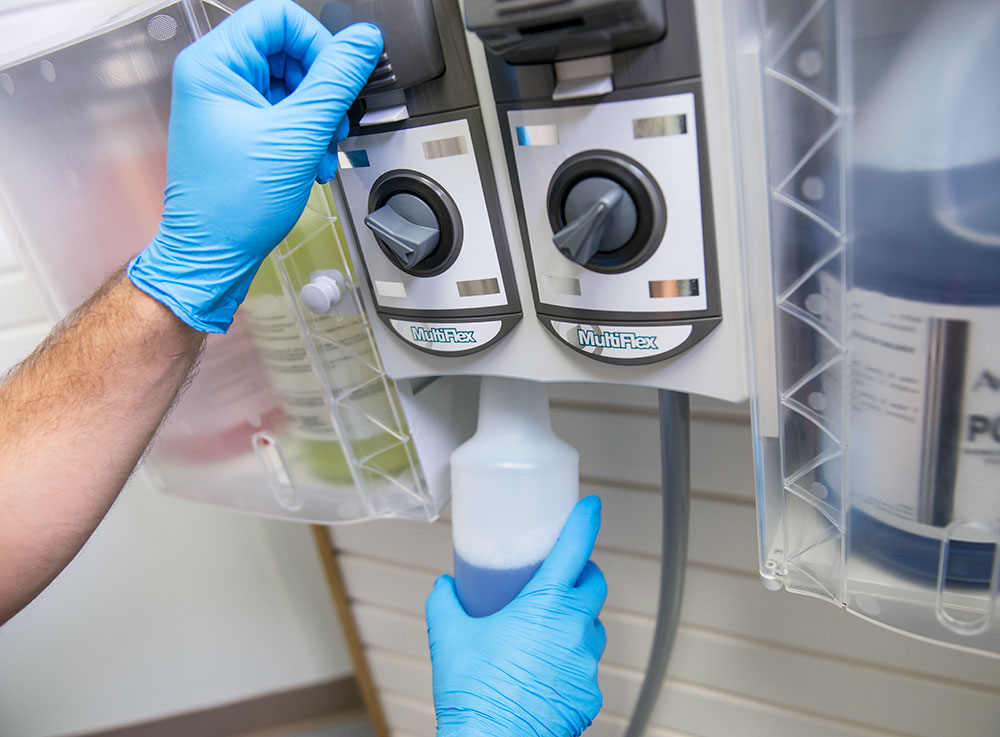Unfortunately, there’s not a guaranteed way to completely avoid contracting a virus such as COVID-19, but by keeping a clean workplace and utilising tools such as chemical dispensers, you can significantly reduce the risk

Wherever people go, germs follow. For this reason, hotels, cruise ships, airlines, schools and universities, offices, retailers, restaurants and healthcare facilities must be prepared. Thankfully, there are several ways to reduce the risk of being exposed to the disease, including:
- Promoting proper hand hygiene. According to the CDC, 80% of all infections are transmitted by hands.[1] However, a recent study showed that close to 97% of people are not properly washing their hands, making it even more important to develop a well-rounded virus prevention strategy.[2] The CDC recommends washing hands with soap and water for at least 20 seconds, and using an alcohol-based hand sanitiser when soap and water are not available.[3] Place the CDC’s COVID-19 prevention posters in bathrooms, kitchen and break rooms and additional areas around the facility to remind employees and guests to follow best practices.[4]
- Limiting exposure. It’s important for employers to encourage employees to stay home if they show signs of illness. When employees come to work while sick, they risk infecting others. While many workers do not have paid sick leave, it is crucial that employees consider their health and the health of others if they are infected. Imposing self-quarantine by staying at home during recovery helps to better control the spread of infection. If possible, employers should also consider having employees work remotely and limit or reschedule travel until the outbreak is under control. Additionally, consider holding virtual meetings to avoid having several people in one room at a time.
- Using the proper cleaning tools. According to the CDC, cleaning and disinfecting frequently touched objects and surfaces is a preventative action to help reduce the spread of respiratory diseases. Updating the janitorial closet before and during an outbreak is a great way to ensure your facility has the right equipment on hand for periods that require extra stock. Use disinfectant solutions that thoroughly kill pathogens. From microfiber cloths and mops to chemical dispensing systems, the right cleaning tools support employees as they work to kill germs. It’s also important to increasing cleaning frequencies to further control the spread of germs. Some retailers are conducting cleaning every half hour to address high-touch surfaces and alleviate shoppers’ fears.[5]
Maintaining a facility during an outbreak requires managers to take certain steps, such as stocking additional cleaning supplies and utilising the right equipment. These precautions don’t stop a virus from entering your building, but they can help limit the spread of infection and keep employees and guests healthier.
Disinfecting Considerations
During an outbreak or pandemic, it’s important to pay special attention to high-touch surfaces when disinfecting, such as restroom counters and sink handles, floors, light switches, door handles, desks, office telephones and more. You should also understand the differences between cleaning, disinfecting and sanitising:
- Cleaning removes dirt, germs and other impurities by using soap or detergent with water to physically remove germs from surfaces. Cleaning doesn’t always kill germs, but removing them helps reduce the spread of infection.
- Disinfecting uses chemicals to kill germs. This process does not always clean a dirty surface or remove germs, but it does kill germs, which lowers the risk of infection.
- Sanitising a surface lowers the number of germs to a safe level according to public health standards or requirements. To sanitise a surface or object, it must be properly cleaned or disinfected.
To promote health and well-being in facilities, clean and disinfect regularly. Surfaces that are visibly soiled, such as food contact surfaces in a kitchen or floors, should be cleaned and disinfected immediately. At minimum, clean and disinfect surfaces to kill germs on a daily basis and more often if cases of coronavirus have been reported in your immediate area. Follow label directions on cleaning products and disinfectants. Most disinfectants require time to work properly, so allow the chemical to dwell on the surface for as long as directed.
It’s also crucial that facilities take the right precautions around linens like bed sheets, towels, employee uniforms, patient gowns and privacy curtains. Hospitality and healthcare facilities have a responsibility to clean these items at the proper temperature and with the right chemicals. The EvoClean venturi-based dispenser is an ideal solution for on-premise and industrial laundry facilities, as it eliminates the service and maintenance associated with traditional squeeze tubes. Dispensing precision helps ensure that linens are cleaned correctly the first time.
Chemical Dispensers
Manually measuring cleaning chemical can put employees in harm’s way. In fact, as the European Agency for Safety and Health at Work describe, many people in the cleaning industry are exposed to potentially dangerous chemicals every day.[6] Improper handling of chemicals can lead to spills which could cause injuries like burns and respiratory problems from fume inhalation. Additionally, using products at the wrong dilution can result in skin irritation and surface damage.
Amid the COVID-19 outbreak, the American Chemistry Council’s (ACC) Center for Biocide Chemistries (CBC) created a list of Environmental Protection Agency (EPA) pre-approved products to use against emerging enveloped viral pathogens.[7] Similarly, many individual European countries’ government agencies are advising on which disinfectants are the best choice for optimum protection in this unprecedented situation. However, without proper dilution, these products won’t achieve their kill claims. If an employee cleans a surface with an improperly diluted solution, germs that cause illnesses like COVID-19 could continue to survive on the surface for hours.
Keeping staff healthy throughout an outbreak means keeping safety top of mind. To prevent workers from being exposed to cleaning chemicals, and to reduce the spread of harmful germs, facilities can install a chemical dispenser.
Chemical dispensers enhance cleaning effectiveness and productivity by:
- Providing accuracy and safety. Dispensers eliminate measuring guesswork for employees. Closed-loop systems prevent spills and exposure to chemicals by eliminating the traditional and unsafe “glug-glug” method of measuring product by hand. With each use, systems accurately dispense the proper amount of chemical and water required. By making cleaning and disinfecting easier, these systems can encourage workers to clean more frequently and properly.
- Promoting a healthy environment.Chemical dispensers help reduce the spread of germs by accurately dispensing disinfecting chemical according to manufacturer recommendations. Dispensing systems can be used to fill spray bottles for surface cleaning and mop buckets or autoscrubber tanks for floor cleaning. Chemical can also be dispensed into sink compartments for warewashing needs. Using a chemical dispenser to perform these tasks helps a facility reduce the spread of germs and uphold its positive reputation.
- Enhancing sustainability and cost savings. When dispensers dose the right amount of chemical, this helps reduce chemical and water use while limiting packaging waste, supporting environmental stewardship and increasing the bottom line. Additionally, it ensures cleaning is done right the first time, improving productivity and reducing labour costs.
- Preventing another outbreak. When an outbreak like COVID-19 hits, facilities everywhere are suddenly reminded to clean areas thoroughly. Using chemical dispensers can help promote cleaning regularly and efficiently, helping to prevent the spread of germs and potentially avoid another outbreak.
Dispensing System Best Practices
When considering investing in a dispensing system, it’s important to review the system’s features as well as tips for installation, training and maintenance. To guide your business when looking for a dispensing system, consider the following best practices:
- Determine who will use the system and how often. A user-friendly interface will simplify training and encourage employees to conduct frequent cleaning. During an outbreak, it’s especially important for employees to clean and disinfect on a daily basis, so the dispensing system needs to function without interruption.
- Make a list of the types of products you use most. If your business uses numerous types of chemical, you’ll need a dispenser capable of managing multiple products without chemical carryover issues. Additionally, if you use multi-purpose products for cleaning and disinfecting, your dispenser will need to provide multiple dilutions to provide accurate measurements.
- Prioritise water flow and pressure. All buildings have different water pressure and flow, and it can vary throughout the day, impacting the dilution of a cleaning or disinfecting solution. Find a dispensing system that is designed to eliminate dilution variance and includes venturi-based units that regulate water flow automatically.
- Search for a smart system. Today, some dispensing systems feature technology that offers predictive maintenance, remote monitoring and automated adjustments. Technology that can record and capture data on dispenser key performance indicators can help an organisation understand how much product, water and energy is being used and track how often the system is being used to meet cleanliness goals. During an outbreak, it’s essential for facility managers to have access to this information to ensure loads of laundry and surfaces were cleaned with the proper solution.
- Select the right area to install the system. Dispensing systems should be installed in an area that is easy to access and where water is readily available. Search for a compact dispensing system that does not take up valuable wall space.
Most importantly, a dispensing system should be well-suited for current and future needs within the business. Over time, keep up with maintenance by checking on the filter, metering tips and tubing. Replace parts as needed and encourage employees to report any possible issues, such as no chemical draw. Taking these steps ensures that your facility is prepared if and when the next outbreak or pandemic occurs.
Creating a Healthy Environment
Widespread outbreaks and pandemics, such as coronavirus, can have a drastic impact on an organisation. From schools to offices to restaurants to retail stores, there are many different facilities that must re-evaluate policies and procedures as the virus continues to spread. To promote the health and well-being of employees, building occupants and visitors, every facility must prioritize regular cleaning and disinfection. Having the right tools in place that support health and wellness, like dispensing systems, helps facilities better maintain cleanliness and improve productivity during times of an outbreak.
Read the full white paper by Hydro Systems here
- [1] http://www.newsmax.com/Health/Health-News/infections-hand-fist-bump/2014/01/09/id/546258/
- [2] https://www.forbes.com/sites/brucelee/2018/06/30/study-shows-how-bad-people-are-at-washing-their-hands/#1b62fc452481
- [3] https://www.cdc.gov/coronavirus/2019-ncov/about/prevention-treatment.html
- [4] https://www.cdc.gov/coronavirus/2019-ncov/downloads/stop-the-spread-of-germs.pdf
- [5] https://www.yahoo.com/lifestyle/target-cleaning-stores-every-30-145205999.html
- [6] https://osha.europa.eu/en/publications/occupational-safety-and-health-cleaning-workers
- [7] https://www.americanchemistry.com/Novel-Coronavirus-Fighting-Products-List.pdf




